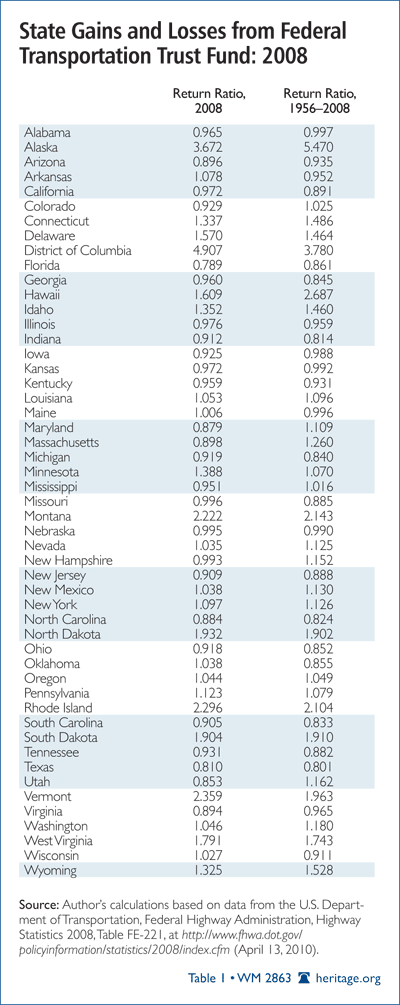Among the many contentious issues that will confront Congress in the months leading up to reauthorization of the federal highway program (now postponed until December 2010) is the program’s inherent inequities relating to the distribution of federal trust fund revenues to the states. Under current law, the federal fuel taxes paid into the trust fund by motorists and truckers are returned to the states by a series of mathematical formulae that attempt to match the scope and usage of each state’s surface transportation system with payments received from the trust fund.[1]
These formulae, however, embody a number of serious flaws that cause many states (called donors) to consistently receive shares that are less than they pay in while others (called donees) consistently receive more. This deficiency in turn exacerbates regional transportation problems because the shortchanged states are typically those with above-average population growth and transportation needs that exceed those of the slower-growing states, which often receive shares that are greater than the amounts that they pay in. While halfhearted efforts have been made in the past to mitigate this problem, there has been little real progress, and the depletion of the trust fund in FY 2008 further complicates reform efforts.
Shortchanging the States
Over the past several decades, states that are shortchanged by the program have been concentrated in the Southeast, the Great Lakes region, and California and Arizona. States receiving more than their fair share have been concentrated in the Northeast and Middle Atlantic regions and the sparsely populated Mountain states.
Column 2 of Table 1 provides state-by-state details on winners and losers in 2008 (the latest data available), and column 3 provides state-by-state details for the years since the program’s inception in 1956.[2] States with a share ratio less than 1.0 are donors and are receiving a smaller share compared to what they pay in. Those whose share ratio exceeds 1.0 are getting back more than their fair share.

In 2008, there were 25 donor states and 25 donees, although many states were close to being even in their return ratios. In 2008, for example, Texas received only an 81 percent payback, costing it $728 million in underpayments that year, while Florida received just 79 percent back, Indiana received 91 percent, and South Carolina received 90 percent. As column 3 reveals, many of the losing states in 2008 have been consistent losers since 1956. Tabulating return ratios over the past 52 years reveals that, among some of the 24 long-term losers, Texas received just 80.1 percent, Oklahoma received 85.5 percent, and Georgia received 84 percent.
Faulty Calculations
One reason that these equity problems persist is that the United States Department of Transportation does not accurately calculate and report state-by-state equity shares and instead measures each state’s share by comparing the sum of dollars paid in to the sum of dollars paid out. Because the trust fund in recent years has paid out more than it receives in taxes, this way of measuring performance indicates that all states earn an above-average return on their payments—which, of course, is a mathematical impossibility. This flaw was corrected by the Bush Administration, and accurate numbers were reported for 2007, but the new Obama team has reverted to the incorrect equity calculations and did not report the correct numbers when the 2008 data were released.
Under the methodology of share or return ratio calculations used in this paper (and briefly adopted by the Federal Highway Administration in its 2007 report), Texas in 2008 experienced an 81.0 percent return ratio, reflecting the fact that its tax revenues accounted for 9.321 percent of the money flowing into the fund compared to the 7.554 percent of trust fund spending that it received (7.554 is 81.0 percent of 9.321).
Donor States Should Push for Reform
The current laws governing the federal highway and transit programs expired in September 2009 but have been extended to December 2010 to allow for more time to develop new legislation. To date, the only draft reauthorization legislation in circulation is one by Congressman James Oberstar (D–MN), chairman of the House Committee on Transportation and Infrastructure, and his incomplete proposal is silent on the equity issue. Moreover, while the Obama Administration has yet to release its reauthorization proposal, much of its transportation focus has been on bicycles and passenger rail, and no mention of equity issues has appeared.
Unless the donor states are well organized and push their case for reform and equity aggressively during this legislative process, they will once again find themselves with what little scraps are left and another five years of annual spending shortfalls.
Ronald D. Utt, Ph.D., is Herbert and Joyce Morgan Senior Research Fellow in the Thomas A. Roe Institute for Economic Policy Studies at The Heritage Foundation.



